Abstract
Background: The global pandemic COVID-19 was identified for the first time in Wuhan, Hubei province, China in September 2019 [1]. Since then, COVID-19 has quickly expanded to neighbor provinces and foreign nations, elevating it to the top of humanity's list of health concern.
Objectives: This study aims to find out the correlation between environmental and social criteria such as temperature, precipitation, GDP etc. and the number of COVID-19 infection cases around the world.
Methods: We used correlation analysis for the database from April, 2020 to August, 2021. Our global COVID-19 data were retrieved from World Health Organization website and the World Air Quality Report.
Results: Based on correlation analysis, this study demonstrates that the spread of COVID-19 is a social issue, rather than an environmental issue.
Conclusions: The correlation analysis in this study is a solid evidence for determining the root causes of the outbreak of the COVID-19 pandemic in different countries.
Keywords: Correlation, GDP, Population, PM2.5, Temperature, Precipitation, Covid-19.
1. Background
COVID-19 is a global pandemic and has taken many lives worldwide, most notably in China, where the coronavirus was first found. The number of people returning to their hometowns in China, including those from abroad [2], is very high. Therefore, the situation of transmission in China is very complicated and became the focus of attention during the pandemic years. It was reported that approximately 5 million people had left Wuhan, according to [3]. China government has not only focused on research and development of drugs and vaccines to fight against the COVID-19 epidemic, but also combined with social isolation measures to prevent cross infection. From the start of the pandemic to the end of 2022, China insisted on the "Zero COVID-19" strategy [4]. Throughout several years of pandemic outbreaks, this strategy has been used in order to minimize the spread of the Corona virus. This is considered the strictest policy to date that we have found.
The COVID-19 epidemic has experienced the most intense outbreak phase and is showing signs of decreasing over time. Currently, many researchers focus solely on morbidity and mortality as well as analysis of social factors for health researchers and policymakers [5] [6] [7]. Illustratively, other studies have also shown the importance of environmental indicators in the transmission of influenza [8] [9].
Population plays a significant factor in the worldwide social isolation. Evidence shows that countries with high cultural level, developed economies often find it difficult to accept social isolation [10], especially the Western countries. Moreover, countries with smaller populations and less developed economic status have easier disease control [11]. For example, the fight against the COVID-19 pandemic is extremely effective in Asian countries like China, with GDP being 17734.06 USD Billion (end of 2021) [12] and population being 1,439,323,776 [13]. The implementation and strict compliance of China's Zero Covid-19 strategy seems to yield good results of fighting this pandemic. With a population density being over four times of that of the USA, China has about 48 times fewer COVID-19 cases (1,655,477 cases compared to over 80 million cases in the USA) and about 74 times fewer deaths (13,524 in China compared to about 1 million in the USA) than the USA [14]. However, the control of the pandemic still faces many difficulties such as a country with a dense population, a lack of medical equipment, the poor and people living in remote areas will find it difficult to access treatment methods and the direction of government.
Social indicators are the most interesting of the studies on predicting the spread of Covid-19. We are talking about the population index and the number of Covid-19 infections [15], overcrowding will give rise to social and community problems such as uncontrollable movement, isolation, business activities, and other problems with accommodation have caused the number of infections to increase continuously. Continents’ population outcomes may be related to population density, easier access to quality health care, and greater experience in controlling COVID-19 infections due to disease numbers. higher multiplier. One could argue that continents with fewer populations have a higher proportion of rural population [16]. Studies have shown that there are significant differences in the overall health care assessment of rural populations compared with urban population.
2. Objectives
This study aims to provide an in-depth overview of the impact of social and environmental factors on the COVID-19 epidemic. Specifically, we aim to determine the relationship between the number of cases along with environmental and social indicators. We will compare the course of the pandemic in some world areas to find out what is the main cause of the outbreak.
Our analysis is that COVID-19 has exploded in developed and densely populated countries. Indeed, we found that the number of COVID-19 cases and Gross Domestic Product (GDP) are highly correlated. This article also provides a demonstration that the transmission of COVID- 19 is related more to social factors than environmental factors. Our research can contribute to the literature on unprecedented pandemic response strategies and serve as a reference to help countries prepare for similar outbreaks in the future.
3. Methods
Our dataset is divided into two parts: region and timeline. The world dataset includes the number of confirmed cases, the environmental and social indicators on the first day of each month, from April 2020 to August 2021. Our global COVID-19 data were retrieved from the World Health Organization (WHO) website [17]. The global data for the climate indicators are retrieved from the World Air Quality Report [18].
Our analysis method involves three consecutive steps: (i) plot of dataset, (ii) correlation analysis from dataset plot and (iii) plot of correlation coefficient values over time. In our study, the empirical correlation estimation of correlation coefficient was used to determine the correlated relationship between variables [3] [19]. In this paper, we mainly used Microsoft Excel to analyze correlation coefficient, as shown in Table 2, Table 3, Table 4 and Table 5 in Appedix.
4. Results
- 4.1. Correlation coefficient over geography
We collected data from 83 countries around the world and then divided into five major regions [20] including Asia, Europe, Africa, America and Oceania, as shown in the Appendix. We then averaged out worldwide on the factors such as population, GDP, temperature, rainfall and airpollutant PM2.5 fine-dust index. Information about the correlation index is summarized and described in Table 1.
Table 1 indicates a significant correlation between the COVID-19 cases and social factors. The correlation between population and number of cases shows that America, Europe and Oceania are very high with correlation 0.954, 0.901 and 0.994, respectively. The GDP correlation coefficient of America (0.933), Europe (0.858), Africa (0.912) and Oceania (0.924) reached an extremely high level, while that of Asia (0.126) is very low. It seems that the COVID-19 spread in Asia is more relevant to population than economy.
On the environmental index, we found that the correlation coefficients are closer to zero. The correlation between PM2.5 and the number of cases of the continents are as follows: Europe (-0.119), America (-0.230), Africa (- 0.153), Oceania (-0.435) and Asia (0.226). For the correlation coefficient between ambient temperature and COVID-19, the value is very low with World (-0,137), Europe (-0.119), America (-0.225), Africa (-0.653), Oceania (0.131) and Asia (0.102). Finally, the correlation coefficient between rainfall and the number of COVID-19 cases is World (-0.049), Europe (-0.108), America (-0.291), Africa (-0.259), Oceania (-0.249) and Asia (0.009). Hence, our environmental factors have little effect on COVID-19 spread in this table.
In the Table 1, we can verify that countries with higher total population, more diverse demographics, higher education and income levels are at higher risk of COVID-19 infection, as shown in [21]. Also, the world average is of slightly high correlation (0.469) in population, but some continents have higher correlation in population such as Europe and America. The possibilities for such high correlation may come from the mobility of work-traveling. Countries with high GDP, economy development often have concentrated industrial zones. which involve uncontrollable infection in the term of social isolation [22].
The correlation coefficient is a measure to determine the linear relationship between two different variables. We will compile data on COVID-19 incidence around the world for correlation plots in this section. Daily data on mean temperature (°C), total precipitation (mm) and airpollutant PM2.5 fine-dust index, along with GDP economic (USD) and population collected in 2021.
- 4.2.1.Correlation coefficient between enviromental factors and COVID-19 case
After performing the calculation of the correlation coefficient between environmental factors and the number of COVID-19 cases, the results are shown in Figure 3 - Figure 5 in the Appendix.
The correlation coefficients between environmental factors and the number of COVID-19 cases include: temperature ( ), rainfall ( ) and PM2.5 dust ( ). With such a very low correlation coefficient R, we can conclude that environmental factors do not have too much influence on the strong development and rapid spread of the global COVID-19 epidemic.
Correlation coefficients between social factors and COVID-19 case
The current situation shows that countries with dense populations or countries with strong economies have a large number of people infected with COVID-19. This is further proven when we look at the correlation coefficient results in Figure 1 and Figure 2 in the Appendix.
The correlation coefficient between population and COVID-19 cases is R=0.557 and the correlation coefficient between GDP and COVID-19 cases is R=0.512. Hence, the correlation coefficient of social factors with COVID-19 is much higher than the correlation coefficient of environmental factors with COVID-19.
This further strengthens the hypothesis that the COVID-19 pandemic is a social problem rather than an environmental problem.
5. Discussion
The purpose of this study is to indicate that environmental factors do not directly influence the formation and spread of COVID-19 outbreaks. The main factors of concern are economic indicators such as GDP and population, which have a significant correlation with COVID-19 pandemic. This paper provides references for authorities and medical facilities for disease prevention and control. In addition, this paper provides a basis for predictive models in countries with alarming indicators related to the COVID-19 pandemic or other infectious diseases.
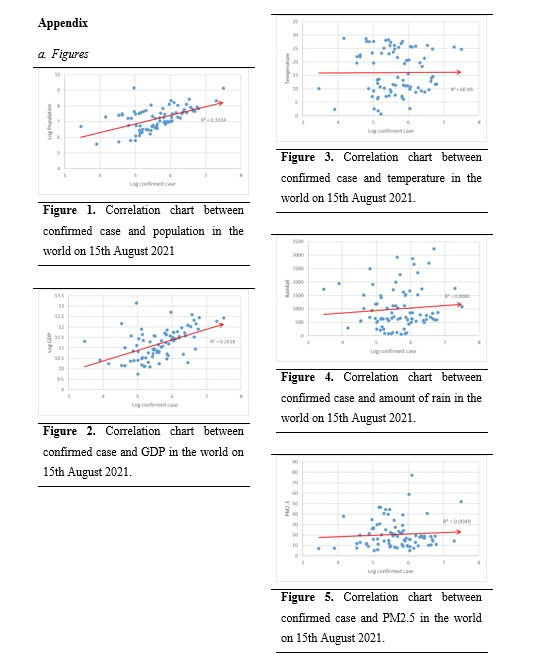
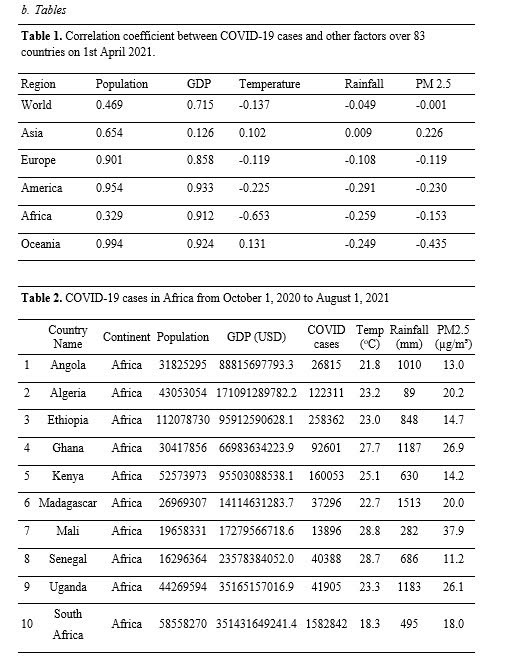
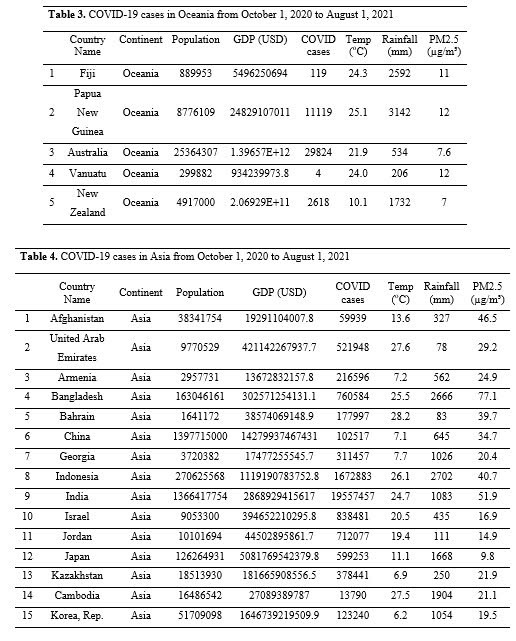
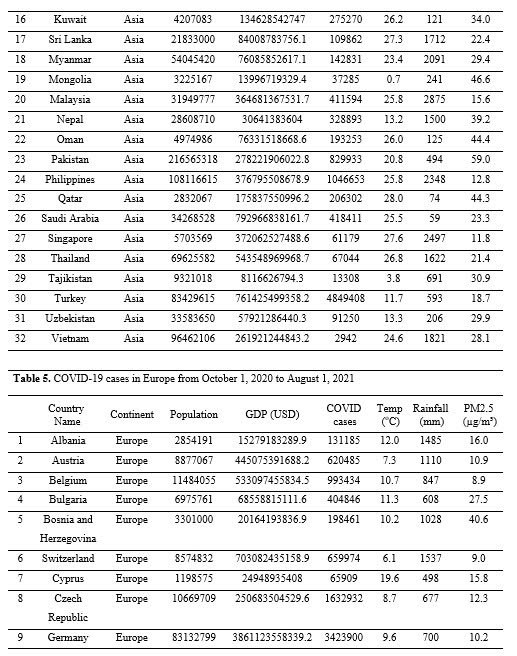
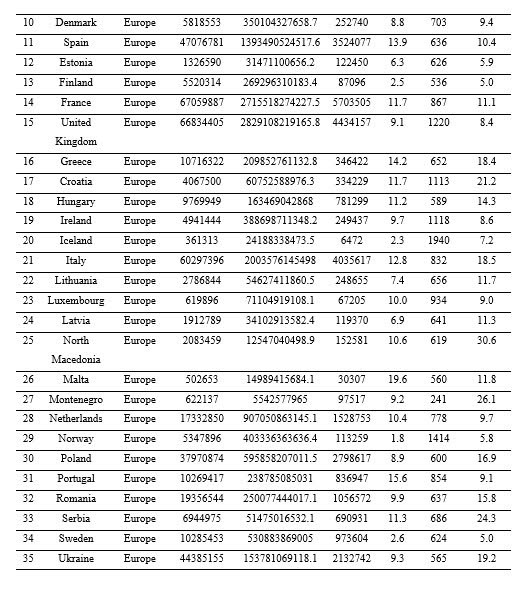
References
- S. Chen, J. Yang, W. Yang, C. Wang and T. Barnighausen, "COVID-19 control in China during mass population movements at New Year," The Lancet, vol. 395, p. 764–766, 2020.
- Mahase and Elisabeth, "China coronavirus: what do we know so far?," BMJ, vol. 368, 2020.
- M. D. Tran, H. H. Tran and V. H. Tran, "Evaluating the Impact of Social Distancing on COVID-19 Spread in Vietnam by using Logistic Growth Curve Model," Journal of Advanced Engineering and Computation, vol. 5, p. 177–188, 2021.
- S. S. S. Lau, C. C. Y. Ho, R. C. K. Pang, S. Su, H. Kwok, S.-f. Fung and R. C. Ho, "COVID-19 Burnout Subject to the Dynamic Zero-COVID Policy in Hong Kong: Development and Psychometric Evaluation of the COVID-19 Burnout Frequency Scale," Sustainability, vol. 14, 2022.
- W. Cullen, G. Gulati and B. D. Kelly, "Mental health in the COVID-19 pandemic," QJM: An International Journal of Medicine, vol. 113, pp. 311-312, March 2020.
- Q. Chen, M. Liang, Y. Li, J. Guo, D. Fei, L. Wang, L. He, C. Sheng, Y. Cai, X. Li, J. Wang and Z. Zhang, "Mental health care for medical staff in China during the COVID-19 outbreak," The Lancet Psychiatry, vol. 7, p. e15–e16, 2020.
- P. Atkinson, N. Gobat, S. Lant, H. Mableson, C. Pilbeam, T. Solomon, S. Tonkin-Crine and S. Sheard, "Understanding the policy dynamics of COVID-19 in the UK: Early findings from interviews with policy makers and health care professionals," Social Science and Medicine, vol. 266, p. 113423, 2020.
- R. Tosepu, J. Gunawan, D. S. Effendy, L. O. A. I. Ahmad, H. Lestari, H. Bahar and P. Asfian, "Correlation between weather and Covid-19 pandemic in Jakarta, Indonesia," Science of The Total Environment, vol. 725, 2020.
- M. Alireza, R. Fatemeh, J. Kimia, M. Leyla, H. Abdolrasool, D. S. Sina, H. A. Hossein, L. Mehrzad, J. Alireza and G.-G. Mousa, "Correlation between environmental factors and COVID-19 indices: a global level ecological study," Environmental Science and Pollution Research, vol. 29, pp. 16667-16677, 01 March 2022.
- Y. Wang, "Government policies, national culture and social distancing during the first wave of the COVID-19 pandemic: International evidence," Safety Science, vol. 135, p. 105138, 2021.
- M. Gupta, R. Jain, S. Taneja, G. Chaudhary, M. Khari and E. Verd, "Real-time measurement of the uncertain epidemiological appearances of COVID-19 infections," Applied Soft Computing, vol. 101, p. 107039, 2021.
- G. D. P. China, China GDP, 2022.
- C. Population, China Population, 2022.
- T. Burki, "Dynamic zero COVID policy in the fight against COVID," Lancet Respir Med., vol. 10, p. e58–e59, June 2022.
- D. Fanelli and F. Piazza, "Analysis and forecast of COVID-19 spreading in China, Italy and France," Chaos, Solitons, Fractals, vol. 134, p. 109761, 2020.
- D. A. Fitzgerald and G. W. K. Wong, "COVID-19: A tale of two pandemics across the Asia Pacific region," Paediatric Respiratory Reviews, vol. 35, pp. 75-80, 2020.
- W. H. Organization, Coronavirus Disease (COVID-19) Dashboard, 2020.
- W. A. Quality, World's most polluted cities 2019, 2019.
- V. H. Tran, "Variational Bayes Inference in Digital Receivers," 2018.
- M. Sarmadi, N. Marufi and V. K. Moghaddam, "Association of COVID-19 global distribution and environmental and demographic factors: An updated three-month study," Environmental Research, vol. 188, p. 109748, 2020.
- L. Liu, J. Hu, Y. Hou, Z. Tao, Z. Chen and K. Chen, "Pit latrines may be a potential risk in rural China and low-income countries when dealing with COVID-19," Science of The Total Environment, vol. 761, p. 143283, 2021.